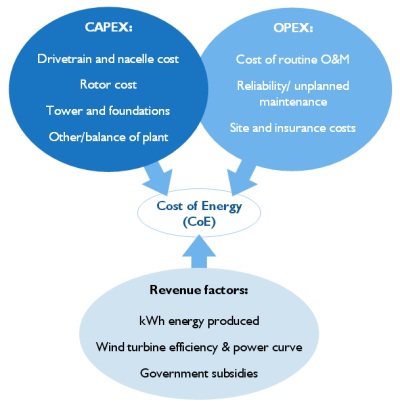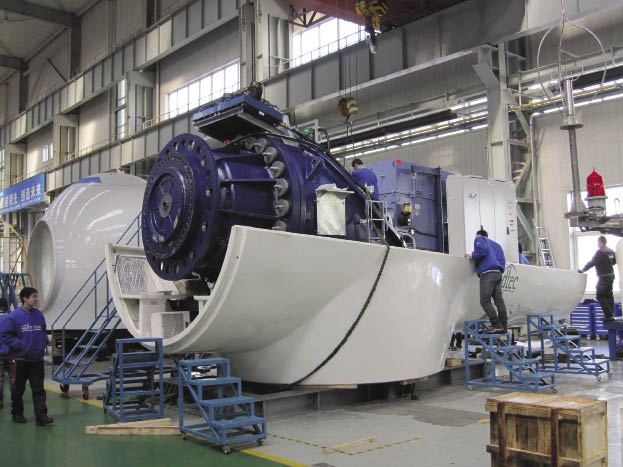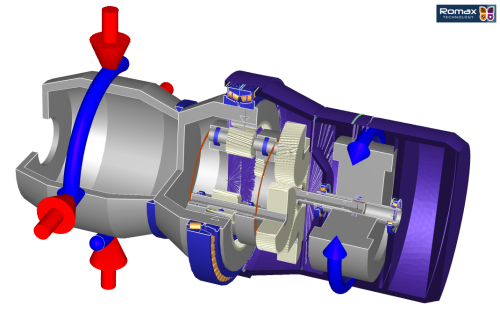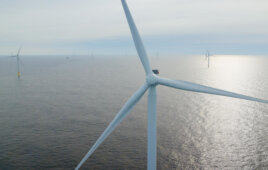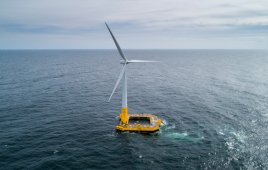After identifying cost drivers for wind-turbine equipment, engineering teams and designers can focus their talents on controlling them.
By: Dr. John Coultate, R&D and Consultancy Dept. Leader, Romax Technology Ltd, UK, www.romaxtech.com
Wind-turbine manufacturers offer a variety of drivetrains using different layouts and concepts for competitive advantages. The market is rich with innovative and advanced solutions, all competing to become established and proven products. Generally, main cost drivers for drivetrain designs fall into several categories:
•High reliability
•Low turbine cost|
•Low cost-of-energy (CoE)
•Ease of maintenance
•Ease of installation
Each area breaks into other factors and requirements. As the wind-turbine industry matures, it is likely these factors will drive wind turbine and drivetrain designs to converge on a small number of common technologies and layouts. The current state of the market, however, is such that step changes in reliability, turbine cost or CoE may still be possible through detailed system-level engineering, drivetrain concept selection, and optimization.
Cost of energy
The overriding requirement for wind power is to produce wind energy at the lowest possible cost. To do so, capital and operational expenditures must be optimized. Capital expenditure (CAPEX) for an on-shore wind turbine is primarily the cost of the turbine itself and the ‘balance of plant’ costs, typically including supporting infrastructure and electrical infrastructure. Operational expenditure (OPEX) for a wind turbine includes the cost of running the site, planned operation and maintenance, and unplanned maintenance due to poor reliability.
The illustration shows several factors influencing CoE. Optimizing the wind turbine drivetrain can significantly impact both CAPEX and OPEX by reducing the turbine cost, and improving reliability and availability.
The illustration, CAPEX cost breakdown for a wind turbine[1] indicates that the gearbox, generator, and power converter account for about 18% of the total cost of the turbine. This is a large proportion of the total cost, even excluding other drivetrain components such as the main shaft, main bearings, and nacelle baseplate.
Historically, market drivers have forced wind turbine OEMs to compete to deliver products with the lowest price (CAPEX). This culture is changing as the industry matures and the operators’ purchasing drivers change from primarily ‘low cost’ to ‘low CoE’. This is already happening, especially in offshore turbines, with most OEMs now promoting a low cost of energy from their machines.[3, 4, 5]
 How costs compare breaks down the total CoE for onshore and offshore wind power. For any turbine design, it should be possible to improve reliability (and hence reduce OPEX) by increasing turbine cost (CAPEX). For onshore wind power, the turbine cost is a large proportion of the total CoE, meaning that an increase in the turbine cost can have a significant negative impact on CoE. The increased CAPEX must be balanced by an even larger reduction in OPEX to reduce the total CoE. However, the OPEX cost is already a relatively small proportion of the CoE (21%) so a large step-change reduction in OPEX will be difficult to achieve. Hence, the wind turbine price is likely to remain as one of the main drivers in onshore wind turbine design.
How costs compare breaks down the total CoE for onshore and offshore wind power. For any turbine design, it should be possible to improve reliability (and hence reduce OPEX) by increasing turbine cost (CAPEX). For onshore wind power, the turbine cost is a large proportion of the total CoE, meaning that an increase in the turbine cost can have a significant negative impact on CoE. The increased CAPEX must be balanced by an even larger reduction in OPEX to reduce the total CoE. However, the OPEX cost is already a relatively small proportion of the CoE (21%) so a large step-change reduction in OPEX will be difficult to achieve. Hence, the wind turbine price is likely to remain as one of the main drivers in onshore wind turbine design.
For offshore wind power, the business equation is quite different because the CAPEX is a smaller proportion of total CoE compared with onshore and OPEX is a larger proportion. As a result the impact of increasing the turbine cost is less significant offshore and if it leads to a corresponding increase in reliability, hence reducing OPEX, then the total CoE can be reduced.
In reality, an increase in drivetrain cost might be associated with a heavier and stiffer nacelle baseplate, larger and more expensive main bearings or gearbox bearings, or a more expensive concept for the generator and electrical system.
It is anticipated that wind turbine reliability will improve with more advanced and more intensive drivetrain testing. A number of whole-drivetrain and whole-nacelle test facilities are currently being developed to meet this need.[6, 7, 8] Additional testing will have the impact of increasing CAPEX due to increased development cost but, if successful, reducing OPEX and CoE through improved reliability.
Drivetrain system-level engineering
The wind turbine drivetrain is typically a system of subcomponents sourced from suppliers or manufactured by the turbine OEM. In the automotive and aerospace industries, great time and effort is focused on drivetrain systems integration, often carried out by a powertrain department or a powertrain systems integrator.

A RomaxWIND deflection simulation model is for initial concept analysis. The red arrows indicate loads. Deflections are exaggerated to make them more obvious.
In automotive engineering, a powertrain systems integrator is responsible for system-level engineering to combine various components and technologies, such as the:
• Gearbox
• Engine
• Axles
• Differential
• Driveshaft
• Driveline testing and validation
To achieve an improvement in wind turbine reliability, it is anticipated that the wind industry will adopt some of these system-level engineering processes. Currently, a wind-turbine designer is responsible for a large number of aspects and components including the rotor, nacelle, hub, tower, main bearings, operation and maintenance, safety systems, loads, turbine control, and pitch and yaw systems. Drivetrain system-integration engineering is often not performed to the required level of detail. For wind turbine development, the equivalent of an automotive powertrain system integrator would be responsible for:
• Drivetrain integration engineering
• System-level behavior and interactions
• Drivetrain concept development
• Gearbox concept selection
• Main bearing design
• Brake and couplings
• Drivetrain testing
• Drivetrain dynamic behavior
• Drivetrain field testing and health monitoring
Drivetrain testing is an important responsibility of the systems integrator. It is essential that established reliability engineering practice is incorporated into wind-turbine development. This means a cross-functional approach to join these key areas includes: (1) identification of potential failure points during design and analysis, (2) realistic drivetrain testing to represent real operating conditions and test for specific failure modes, (3) reliability and performance data gathered during field operation, and (4) test data and field data used to drive better design practice and better drivetrain testing methods. These four topics are addressed during wind-turbine design but they are generally ineffectively joined. The drivetrain systems integrator is best placed to ‘close the loop’ from design, testing, and field validation back to improved design practice.
Drivetrain concepts for horizontal-axis wind turbines have developed over a relatively short period. Consequently, the market remains diverse and many feasible drivetrain concepts exist, all of which offer advantages and challenges for turbine designers.

The bar segments identify approximate total CoE for onshore and offshore wind power installations.Bar heights represent total absolute cost.
Modular geared drivetrains
For many years the dominant drivetrain technology has been a modular concept consisting of a gearbox and high-speed generator, typically running at 1,200 to 1,800 rpm. The basic layout for this concept appears in the illustration Two point mounted high speed modular drivetrain.
High-speed modular drivetrains generally fall into two categories: three-point mounted drivetrains with a single main bearing, and ‘two-point mounted’ drivetrains with two main bearings. Two-point mounted concepts potentially have a higher cost because of the additional main bearing but can succeed in isolating the gearbox from non-torque loads. This can lead to a lighter, more reliable, and lower-cost gearbox. However, drivetrain alignment becomes more critical, leading to tighter assembly tolerances and requirements for baseplate stiffness.
One market trend for modular geared drivetrains has them remaining a dominant technology, especially for wind turbines up to 5 MW.
Recent years have seen more compact, integrated drivetrain concepts. One example of this is a drivetrain, with integrated main shaft and main bearings, has the advantage of transmitting non-torsional rotor loads directly into the nacelle baseplate and tower. This concept still incorporates a modular generator but can potentially deliver size and weight advantages over a traditional modular drivetrain. The main challenge for an integrated main shaft design is that detailed analysis of the drivetrain is required as the gearbox housing and gearbox bearings transmit non-torsional loads. This challenge can be overcome using a detailed six degree-of-freedom simulation model.

A two-point mounted high-speed modular drivetrain layout (not to scale) shows an integrated main shaft design.
Medium-speed integrated drivetrains
As wind turbine manufacturers develop new turbines above 6 MW, a significant trend has been to use medium-speed drivetrains. For example, the Vestas V164 7 MW, Daewoo Shipbuilding and Marine Engineering (DSME) 7 MW, AREVA M5000 5 MW, and Gamesa’s 4.5, 5, and 7-MW turbines all use medium-speed drivetrains.
A medium-speed drivetrain (with a lower ratio gearbox and just one or two gear stages) drives a larger generator than a high-speed version. Close integration or close-coupling of the gearbox and generator in these concepts can overcome issues caused by misalignment between the gearbox and generator.
Analysis indicates that medium-speed concepts can offer a CAPEX cost advantage over other concepts for large megawatt drivetrains. Medium-speed drivetrains also avoid the need for a high-speed stage, known to be a common failure point on high-speed modular designs.
Direct-drive drivetrains
Direct-drive wind turbines have been a proven technology for onshore installations for several years. Currently, manufacturers including Seimens, GE, and Nordex, are promoting and pioneering direct-drive concepts for large offshore turbines from 4 to 6 MW.
Direct-drive drivetrains offer the advantage of no gearbox and fewer moving parts compared with geared drivetrains. However, they also come with significant engineering challenges, especially in supporting a large, heavy generator and maintaining a small generator air gap. It is therefore essential to understanding the behavior of the whole drivetrain and generator under operating loads. The reliability of direct drive technology still remains unproven for large offshore units but a number of field tests are underway.
The future success of direct drives ultimately comes down to the total cost of energy and the relationship between CAPEX and OPEX. Direct-drive turbines are generally more expensive than turbines with geared drivetrains so it is likely that the additional CAPEX will outweigh any perceived advantage in OPEX for most size ranges, particularly for offshore applications.
Looking ahead
The main driver in any drivetrain design decision ultimately boils down to the cost of energy. The wind-turbine market is rapidly evolving and the industry is increasingly focusing on this as key point for concept selection. The relationship between CAPEX and OPEX costs is complex and the business equation is different for onshore and offshore markets. This is likely to drive different designs for onshore and offshore turbines, which will ultimately lead to a reduction in the cost of energy from future large wind turbines.
To achieve a reduction in CoE, the component costs of a drivetrain must not be considered by a drivetrain designer or turbine manufacturer in isolation from the total business case for the wind farm. In particular, for offshore wind, the realization that OPEX can have a far more significant role in the CoE equation brings a dimension that requires a highly sophisticated approach to technology selection and design.
Drivetrain integration and system-level engineering are key factors in decreasing the overall drivetrain cost and improving reliability. These will drive down OPEX costs but require additional up-front investment in design and engineering. For instance, it would involve tasks such as whole-system testing and analysis. It is by overcoming these costs, as other industries have done in the past, that the wind industry can reduce the total cost of energy from wind power. WPE
FOR FURTHER READING:
[1] Emerging Energy Research [2] Adapted from Vestas [3] Vestas, “Big is Beautiful… Why Larger Wind Turbines Improve Cost of Energy for Offshore Wind”, EWEA Offshore 2011 conference [4] Siemens, “Siemens starts operating its first 6 megawatt wind turbine”, http://www.siemens.co.uk/en/news_press/index/news_archive/siemens-6-megawatt-wind-turbine.htm [accessed December 2011] [5] Nordex, ”Nordex Goes Offshore”, http://www.nordex-online.com/fileadmin/MEDIA/Praesentation/Nordex_Offshore_PK_05042011.pdf [accessed December 2011] [6] Narec, “15 MW Wind Turbine Drive Train Test Facility”, http://www.narec.co.uk/15mw_wind_turbine_drive_train_test_facility/ [accessed December 2011] [7] Clemson University, “State-of-the-Art Wind Turbine Drivetrain Testing Facility” http://clemsonenergy.com/about/about-us/ [accessed December 2011] [8] LORC, “Lindoe Offshore Renewables Center”, http://lorc.dk/cgi-bin/lorc/uploads/media/LORC_Ricardo-side-event-EWEA-2011.pdf [accessed December 2011]
Filed Under: Components, Featured, Offshore wind


